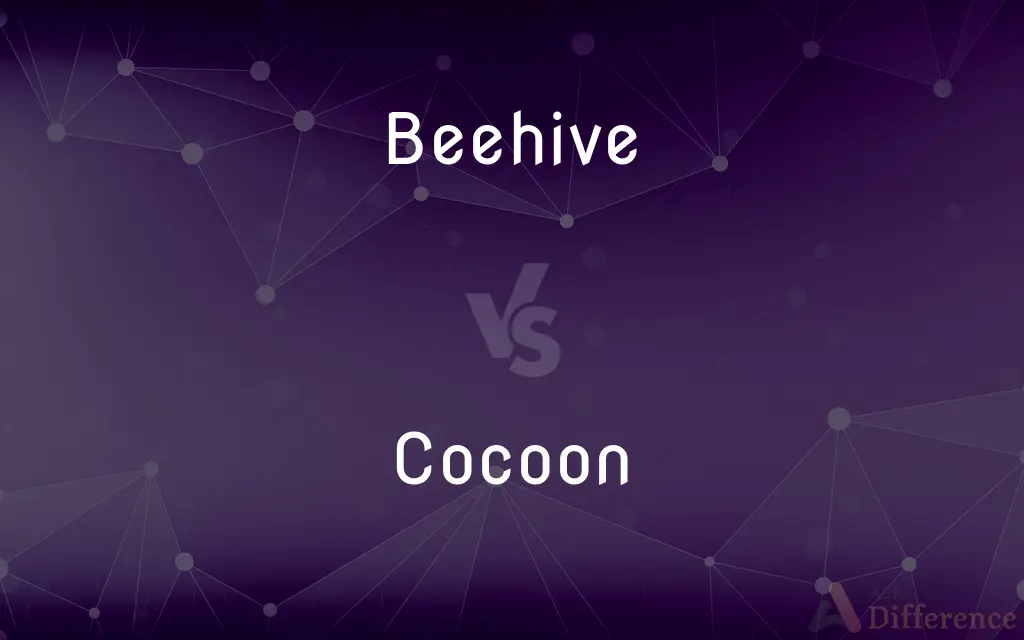Beehive vs. Cocoon — What's the Difference?
By Maham Liaqat & Urooj Arif — Updated on February 22, 2024
A beehive is a structure built by bees to house their colonies and store honey, while a cocoon is a protective casing spun by larvae, particularly those of moths and butterflies, during their pupal stage before emerging as adults.

Difference Between Beehive and Cocoon
Table of Contents
ADVERTISEMENT
Key Differences
Beehives are intricate structures created by bees, particularly honeybees, serving as their living space. These hives consist of numerous hexagonal wax cells, which bees use to store honey and pollen, and to house their brood (eggs, larvae, and pupae). Beehives can be found in the wild, attached to trees or under rock overhangs, but humans also provide artificial hives for beekeeping, aiding in honey production and pollination services.
Cocoons, on the other hand, are protective coverings made by insect larvae as they transition to the pupal stage. The cocoon's primary purpose is to provide a safe environment for the vulnerable pupa, shielding it from predators and harsh environmental conditions. Not all insects create cocoons; this behavior is characteristic of moths and some butterflies. The material and appearance of cocoons can vary widely, from silk-like fibers to more rigid structures incorporating materials from the larvae's environment.
Both beehives and cocoons are related to insects and their life cycles, they serve different purposes and are created by different processes. Beehives are communal structures built for the survival and reproduction of bee colonies, involving complex social behaviors and construction skills. Cocoons, in contrast, are individual protective cases for the metamorphosis of a single insect, reflecting a solitary phase in the insect's lifecycle.
Beehives represent a collective effort by a colony, showcasing the highly social and cooperative nature of bees. The architecture of a beehive, particularly the geometric efficiency of hexagonal cells, is admired for its strength and space optimization, reflecting bees' sophisticated natural engineering.
Cocoons embody the transformational phase of insects, marking a period of significant biological change. The process of creating a cocoon and the metamorphosis within are examples of nature's complexity and the strategies insects employ for survival and development.
ADVERTISEMENT
Understanding the distinction between beehives and cocoons is important for appreciating the diversity of insect behaviors and the various strategies they use for reproduction, growth, and survival. These structures highlight the intricate relationships between insects and their environments, as well as the roles they play in ecosystems.
Comparison Chart
Purpose
Houses bee colonies and stores their honey and pollen.
Provides a protective environment for the pupal stage of certain insects.
Creator
Constructed by bees, specifically honeybees.
Spun by insect larvae, notably those of moths and some butterflies.
Structure
Comprised of hexagonal wax cells within a larger enclosure.
A single protective case, often spun from silk or incorporating environmental materials.
Use
Supports bee reproduction, honey storage, and colony living.
Encases the larva during metamorphosis into its adult form.
Social Aspect
Represents communal living and collective effort.
Reflects a solitary phase in an insect's lifecycle for individual transformation.
Compare with Definitions
Beehive
Home for bee colonies.
The beehive buzzed with activity as bees returned with pollen.
Cocoon
Protective case for pupae.
The caterpillar spun a silk cocoon around itself on the branch.
Beehive
Site for honey production.
The farmer harvested honey from the artificial beehive.
Cocoon
Pupal stage enclosure.
Inside the cocoon, the larva transformed into a butterfly.
Beehive
Natural or artificial hive.
We spotted a wild beehive hanging from the tree branch.
Cocoon
Silk or fiber wrapping.
The moth larva's cocoon was intricately woven from fine silk.
Beehive
Symbol of industry and cooperation.
The beehive in the community garden exemplified nature's efficiency.
Cocoon
Symbol of transformation.
The cocoon represented the impending metamorphosis of the insect.
Beehive
Structure with hexagonal cells.
Inside the beehive, bees meticulously filled each cell with honey.
Cocoon
Individual insect shelter.
Each cocoon in the garden contained a developing pupa.
Beehive
A very busy place.
Cocoon
Wrap in or as if in a cocoon, as for protection.
Cocoon
A silky case spun by the larvae of many insects for protection as pupae.
The moth emerged from its pale yellow papery cocoon.
Common Curiosities
Do all insects create cocoons?
No, only certain insects, such as many moths and some butterflies, create cocoons for their pupal stage.
Can beehives be found anywhere besides trees?
Yes, beehives can also be found under rock overhangs, in cavities, or in man-made beekeeping structures.
How do bees construct their hives?
Bees construct their hives by secreting wax from their bodies, then molding it into hexagonal cells that make up the hive.
What happens inside a cocoon?
Inside a cocoon, the larva undergoes metamorphosis, transforming from its larval stage into an adult insect, such as a moth or butterfly.
Is beekeeping beneficial for bee populations?
Responsible beekeeping can support bee populations by providing safe habitats and helping in the conservation of endangered species.
What's the difference between a cocoon and a chrysalis?
A cocoon is a protective case spun by some larvae, while a chrysalis is the hard shell of the pupa in butterflies, formed without spinning a cocoon.
Are cocoons made only of silk?
While many cocoons are made of silk, some may incorporate other materials like leaves, twigs, or even soil for added protection.
How long does an insect stay in a cocoon?
The duration varies among species but can range from a few weeks to several months, depending on environmental conditions.
Are artificial beehives similar to natural ones?
Artificial beehives mimic the structure of natural hives but are designed for ease of honey collection and colony management.
Do all bees live in hives?
Not all bees are social and live in hives; many species are solitary and do not construct communal structures.
How do environmental factors affect cocoon formation?
Temperature, humidity, and the presence of predators can influence when and where cocoons are formed, as well as their structure.
What role do beehives play in ecosystems?
Beehives support pollination, which is crucial for the reproduction of many plants and the overall health of ecosystems.
Can a beehive exist without a queen?
A beehive needs a queen for reproduction and colony stability; without one, the hive may decline or become nonviable.
What materials are used to make artificial beehives?
Artificial beehives are commonly made from wood, though some modern versions use plastics or other synthetic materials.
How is the health of a beehive monitored?
Beekeepers monitor hive health by checking for disease, parasite levels, food stores, and the presence of a healthy queen.
Share Your Discovery

Previous Comparison
Autotroph vs. Heterotroph
Next Comparison
Quagga vs. ZebraAuthor Spotlight
Written by
Maham LiaqatCo-written by
Urooj ArifUrooj is a skilled content writer at Ask Difference, known for her exceptional ability to simplify complex topics into engaging and informative content. With a passion for research and a flair for clear, concise writing, she consistently delivers articles that resonate with our diverse audience.














































